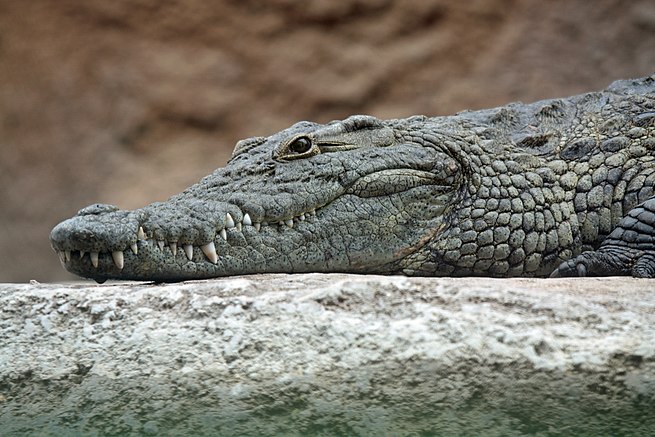Main Difference
The main difference between Crocodile and Alligator is that the Crocodile is a large reptilian carnivore and Alligator is a genus.
-
Crocodile
Crocodiles (subfamily Crocodylinae) or true crocodiles are large aquatic reptiles that live throughout the tropics in Africa, Asia, the Americas and Australia. Crocodylinae, all of whose members are considered true crocodiles, is classified as a biological subfamily. A broader sense of the term crocodile, Crocodylidae that includes Tomistoma, is not used in this article. The term crocodile here applies to only the species within the subfamily of Crocodylinae. The term is sometimes used even more loosely to include all extant members of the order Crocodilia, which includes the alligators and caimans (family Alligatoridae), the gharial and false gharial (family Gavialidae), and all other living and fossil Crocodylomorpha.
Although they appear similar, crocodiles, alligators and the gharial belong to separate biological families. The gharial, with its narrow snout, is easier to distinguish, while morphological differences are more difficult to spot in crocodiles and alligators. The most obvious external differences are visible in the head, with crocodiles having narrower and longer heads, with a more V-shaped than a U-shaped snout compared to alligators and caimans. Another obvious trait is that the upper and lower jaws of the crocodiles are the same width, and the teeth in the lower jaw fall along the edge or outside the upper jaw when the mouth is closed; therefore, all teeth are visible, unlike an alligator, which possesses in the upper jaw small depressions into which the lower teeth fit. Also, when the crocodile’s mouth is closed, the large fourth tooth in the lower jaw fits into a constriction in the upper jaw. For hard-to-distinguish specimens, the protruding tooth is the most reliable feature to define the species’ family. Crocodiles have more webbing on the toes of the hind feet and can better tolerate saltwater due to specialized salt glands for filtering out salt, which are present, but non-functioning, in alligators. Another trait that separates crocodiles from other crocodilians is their much higher levels of aggression.Crocodile size, morphology, behaviour and ecology differ somewhat among species. However, they have many similarities in these areas as well. All crocodiles are semiaquatic and tend to congregate in freshwater habitats such as rivers, lakes, wetlands and sometimes in brackish water and saltwater. They are carnivorous animals, feeding mostly on vertebrates such as fish, reptiles, birds and mammals, and sometimes on invertebrates such as molluscs and crustaceans, depending on species and age. All crocodiles are tropical species that, unlike alligators, are very sensitive to cold. They separated from other crocodilians during the Eocene epoch, about 55 million years ago. Many species are at the risk of extinction, some being classified as critically endangered.
-
Alligator
An alligator is a crocodilian in the genus Alligator of the family Alligatoridae. The two living species are the American alligator (A. mississippiensis) and the Chinese alligator (A. sinensis). Additionally, several extinct species of alligator are known from fossil remains. Alligators first appeared during the Oligocene epoch about 37 million years ago.The name “alligator” is probably an anglicized form of el lagarto, the Spanish term for “the lizard”, which early Spanish explorers and settlers in Florida called the alligator. Later English spellings of the name included allagarta and alagarto.
-
Crocodile (noun)
Any of the predatory amphibious reptiles of the family Crocodylidae; a crocodilian, any species of the order Crocodilia, which also includes the alligators, caimans and gavials.
-
Crocodile (noun)
A long line or procession of people (especially children) walking together.
-
Crocodile (noun)
A fallacious dilemma, mythically supposed to have been first used by a crocodile.
-
Crocodile (verb)
To speak one’s native language at an Esperanto-language gathering, rather than Esperanto.
-
Alligator (noun)
Either of two species of large amphibious reptile, Alligator mississippiensis or Alligator sinensis, in the genus Alligator within order Crocodilia, which have sharp teeth and very strong jaws and are native to the Americas and China, respectively.
“All you could see of the alligator were its two eyes above the water, and suddenly it snatched up and caught the poor bird with its strong jaws full of sharp teeth.”
-
Alligator (noun)
Any of various machines with strong jaws, one of which opens like the movable jaw of an alligator.
-
Alligator (noun)
A form of squeezer for the puddle ball.
-
Alligator (noun)
A rock breaker.
-
Alligator (noun)
Any of various vehicles that have relatively long, low noses in front of a cab or other, usually windowed, structure.
-
Alligator (noun)
One who binds or ties.
-
Alligator (verb)
To crack in a pattern resembling an alligator’s skin.
-
Alligator (interjection)
Used in a common chronometric counting scheme, in which each iteration is sequentially numbered and supposed to be approximately one second in length.

